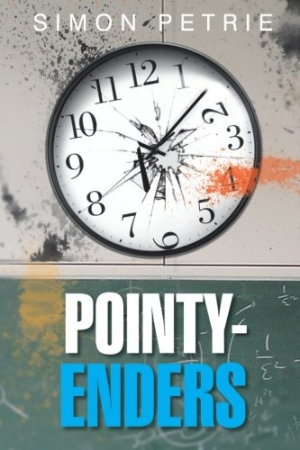Pointy-Enders
Kids on the narrow end of the school resource pool, the tough cases, are given a human face by an author who has worked in the trenches.
Experienced educator Simon Petrie reports from the trenches of Australian public schools with Pointy-Enders, an insider’s look at how teachers and schools cope with their most challenging students. Noting that Australia’s easygoing reputation often belies the harsh realities experienced by its poorest citizens, Petrie convincingly portrays the children who come to school traumatized by dire living situations, and the teachers who try to help, even when that means figuring out “how to remove a screaming, swearing, biting, scratching, spitting, punching, and kicking bundle of child.”
Pointy-Enders follows Hugo Walker, an apparent stand-in for Petrie himself, in his daily rounds as the behaviour management teacher who is “charged with the express function of dealing with violent, uncontrollable, or antisocial behaviour in children” at the Kookaburra Primary School. While Kookaburra’s students are composite characters, Petrie’s real-life experience as a “school bouncer”—he’s the one classroom teachers call to “remove undesirables, round up strays, police the exits, or defuse explosive situations”—comes through loud and clear in stories of kids like Shacair, a young troublemaker sent to the principal’s office for disrupting lessons. It becomes clear that classroom behavior is the least of the seven-year-old’s problems. His mother is in jail, leaving Shacair and his siblings to fend for themselves. The school staff does what it can—making sure the boy has lunch, for starters—but the underlying problems remain unresolved, and this reveals the book’s message: schools are not equipped to solve the much larger issues many of their students face.
The so-called pointy-enders, kids at the narrow end of the resource pool, for whom “getting meaningful help is always difficult and sometimes impossible,” are the focus of the book. Hugo is painted as exasperated and frustrated, but never daunted, as he confronts the daily chaos with a mature mixture of affection and discipline. He rescues older kids like Kahleb, whose love of foul language is topped only by his need to climb to high places, and younger students like Ben, who copes with the stress of the classroom by alternately inflicting violence on his classmates and huddling under his own desk.
The book is broken into topical chapters—“Acronym Soup” covers the array of medical diagnoses given to students, while “Sex and the 7-Year-Old” covers sexual-abuse issues, for instance—but the kids’ stories have many similarities and begin to blend with one another. A few more deeply developed stories might make more of an impact. On the other hand, the sheer number of incidents creates a palpable sense of the relentless nature of this daily work.
The challenges at Kookaburra are presented in a straightforward style with realistic dialogue, and it’s clear that Hugo’s decisions are driven by his immense affection for the students. For instance, he settles a dispute between students over a stolen scooter—not by accusing any particular student, but simply by asking, “Okay, guys, what’s the go?” As he listens to the kids, they calm down, the rightful owner of the scooter claims it, and the school day continues with little disruption.
Although the focus is on an Australian primary school, parents and teachers from other countries will recognize the problems. While solutions and alternatives are not adequately discussed, Pointy-Enders at least starts the conversation by exposing a broken system and giving its most powerless participants a human face.
Reviewed by
Sheila M. Trask
Disclosure: This article is not an endorsement, but a review. The publisher of this book provided free copies of the book and paid a small fee to have their book reviewed by a professional reviewer. Foreword Reviews and Clarion Reviews make no guarantee that the publisher will receive a positive review. Foreword Magazine, Inc. is disclosing this in accordance with the Federal Trade Commission’s 16 CFR, Part 255.

